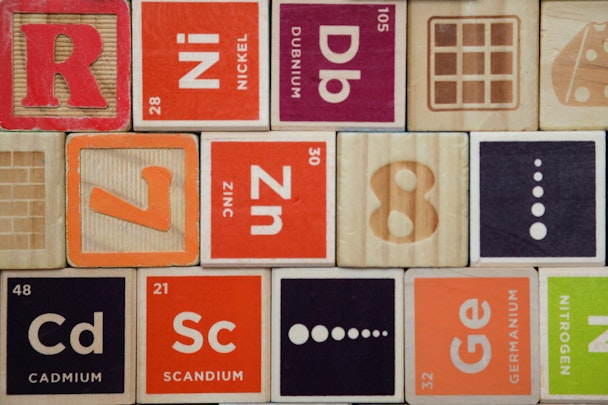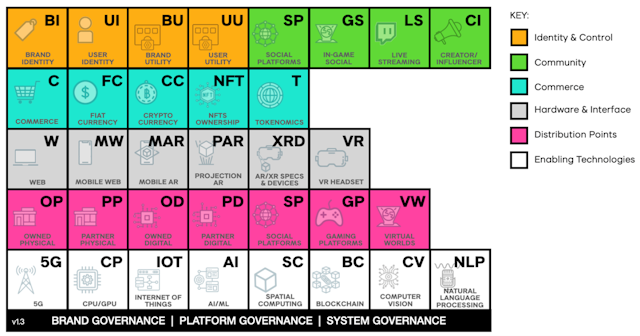‘The metaverse is dead; long live the metaverse’: emerging tech’s table of elements
For The Drum’s deep dive into AI, web3 and emerging tech, VMLY&R’s chief innovation officer shares a metaverse ‘table of elements’ to separate the over-hyped from the underappreciated.

The metaverse isn’t one thing, but many. Will a ‘table of elements’ help marketers to understand it? / David Ballew via Unsplash
The metaverse got more than its 15 minutes of fame. There was a steady rise of hype in 2021 capped by Facebook’s renaming as Meta. Many marketers had a massive case of Fomo fever and felt pressured to jump in.
2022 was going to be the year of the metaverse. Crypto advertisers were all over the Super Bowl. Mass audiences were supposed to jump in, but as the year progressed, audiences didn’t show up quite as predicted. NFTs, ‘the next big thing’, began to devalue. FTX crashed. The metaverse remained at best a muddled concept.
The metaverse was and is full of promise and possibility. But it’s a work in progress: the promise of ‘interoperable’ 3D worlds that are connected to our real world. The prospects of web3 and decentralization promise to unlock new models and value. But those are forward-looking statements and not a guarantee of future performance.
Advertisement
The metaverse is a paradox. Many of the technologies powering it are quite mature, but the standards and norms of the metaverse are not. It’s like the early days of the internet. Or e-commerce. Or mobile. Or social. We’ve been here before.
Whether you’re a metaverse optimist or pessimist, focus on this cold, hard truth: the technologies powering the metaverse are not going away. They’ll inevitably get better, faster. The hardware will get smaller and cheaper. So don’t buy in to the myth of the demise of the metaverse. Instead, focus on the technologies that enable it.

We created the VMLY&R Metaverse Table of Elements to help organize these enablers. With apologies to any actual scientists, this construct begins to organize those elements into working groups. These are the levers we can use as marketers and experience makers.
Advertisement
1. Enabling technologies
At the bottom of the table are the enabling technologies: the underlying tools that make the metaverse possible. They’re essential to know and understand because they underpin so much.
It’s also important to think about non-technological foundations, like guardrails and governance. What is OK to do as a brand? What rules and best practices do you need to have in place for brand and business safety?
2. Distribution points
The metaverse was always much more than virtual worlds. It’s the integration of our digital and physical spaces, like owned and partner physical and digital locations, or extensions into social platforms or gaming. And yes, virtual worlds.
Where you choose to engage will dramatically affect the amount of control or customization that is possible for your brand and audiences. And how large of an audience you might reach. Choose wisely.
Suggested newsletters for you
3. Hardware and interface
The next layer is hardware and interface: the doorways into the experience; the devices your audiences need to access. Web, mobile web, mobile apps and webAR are very common. Projection AR and coming AR specs and headsets and VR headsets are scaling.
Be aware of the potential reach or addressable audience of each — VR headset sales exploded in 2021 and were still strong in 2022, but they were still dwarfed by mobile phones.
4. Identity and control
How does your brand show up and what level of control do you have? Think about your personal gaming experiences: usually, you select an avatar from an existing set of choices. In many virtual worlds, you have more creative license and control over the identity you create and the character you use. That same variability exists for brands.
Marketers must consider what functionality or experiences a brand (and its audiences) can create, and how much you need to conform within a given environment or gameplay/experience structure.
5. Creating and capturing value
Brands must consider what they sell (digital or physical goods) and where they sell it (online or offline). With Web3, they can explore new ways to create value for audiences.
Although cryptocurrencies have plummeted recently, the concept and potential of digital value are still extremely high. Platforms like Fortnite and Roblox have each generated billions of real dollars from virtual goods, mostly decorations for avatars. Some of your audiences think their digital identities are the most authentic version of themselves, and they spend time and money accordingly. Think about what you might sell, and determine how they buy (fiat currency, cryptocurrencies or tokenomics).
6. Community
What communities are you engaging with and activating? Think about the existing communities already connected to the brand and the communities that are active within the new environments you’re entering.
Especially in emerging worlds, creators and influencers tend to be the same people. These are the circles of community to consider and activate through direct interactions within the game and extended social experiences through streaming and social communities.
Ready or not
Call me an optimist. I believe in the power of technology. And I have zero doubt that tech will only improve. It’s inevitable. We may or may not still be talking about the metaverse when it scales, but it’s coming.
Don’t wonder whether you should enter the metaverse or not. Instead, ask how you might leverage these capability areas and emerging technologies to create something amazing for your brand and audiences. Explore. Experiment. How could you tell stories in more powerful and immersive ways? What can you do to improve the customer experience that may not have been feasible in the past? Today, nearly anything is possible, and it will only get better. There’s never been a more exciting time to create.
The metaverse is dead. Long live the metaverse.
For more hot takes and cold hard looks at the emerging tech landscape, check out The Drum’s deep dive on AI to web3.
Content by The Drum Network member:

VML
VML is a leading creative company that combines brand experience, customer experience, and commerce, creating connected brands to drive growth. VML is celebrated...
Find out more
